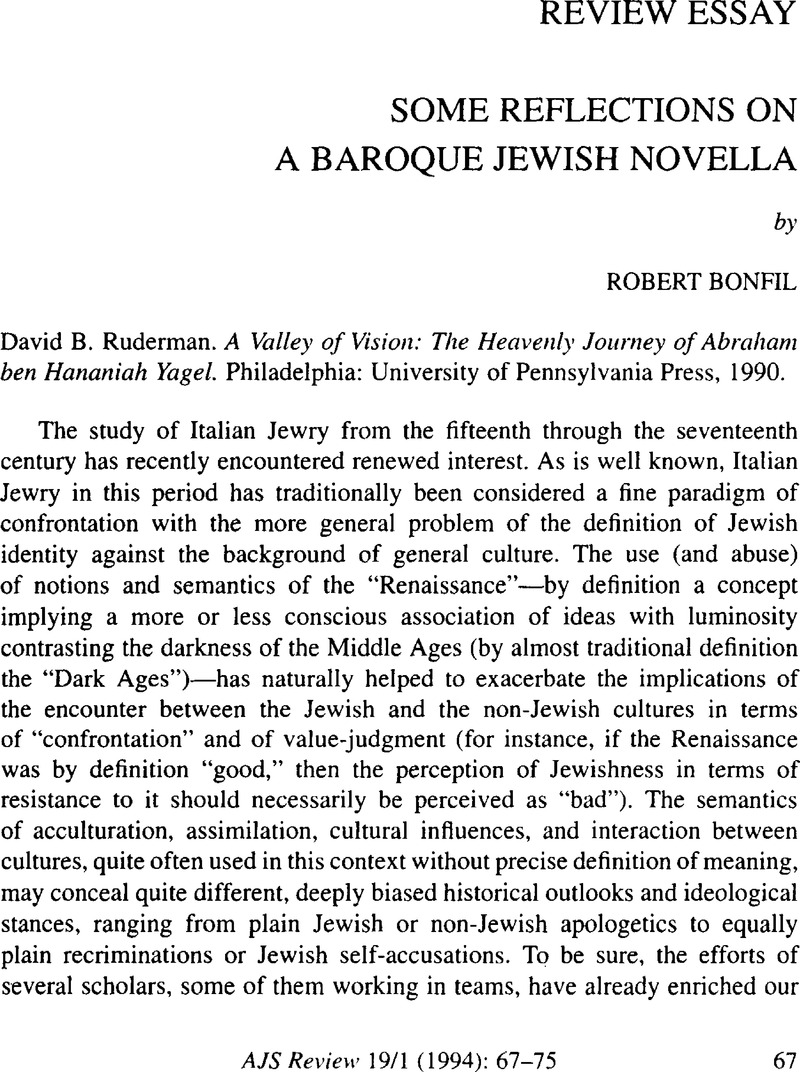No CrossRef data available.
Article contents
Some Reflections on a Baroque Jewish Novella
Published online by Cambridge University Press: 15 October 2009
Abstract

- Type
- Review Essay
- Information
- Copyright
- Copyright © Association for Jewish Studies 1994
References
1. Ruderman, D. B., “The Italian Renaissance and Jewish Thought,” in Renaissance Humanism: Foundations and Forms, ed. Rabil, A., vol. 1 (Philadelphia, 1988), p. 382 (emphasis added).Google Scholar
2. Indeed, one may hardly miss the significance of such questions for the perception of the identity of any modern Jew.
3. See Ruderman, D. B., The World of a Renaissance Jew: The Life and Thought of Abraham ben Mordecai Farissol(Cincinnati, 1981).Google Scholar
4. His more recent contributions include: “The Impact of Science on Jewish Culture and Society in Venice (With Special Reference to Jewish Graduates of Padua'S Medical School),” in Gli Ebrei e Venezia,ed. Cozzi, G. (Milan, 1987), pp. 417–448; and Science, Medicine, and Jewish Culture in Early Modern Europe,Spiegel Lectures in European Jewish History, no. 7 (Tel-Aviv, 1987).Google Scholar
5. Ruderman, David B., Kabbalah, Magic, and Science: The Cultural Universe of a Sixteenth-Century Jewish Physician(Cambridge, Mass, 1988).Google Scholar
6. Cohen, I. Bernard, “Some Recent Books on the History of Science,” in Roots of Scientific Thought: A Cultural Perpective ed. Philip P. Wiener and Aaron Noland (New York, 1957), pp. 627–628, 632.Google Scholar
7. See, for instance, Lloyd, G. E. R., Magic, Reason and Experience: Studies in the Origin and Development of Greek Science(Cambridge, 1979)Google Scholar; and Tambiah, Stanley Jeyaraja, Magic, Science, Religion, and the Scope of Rationality (Cambridge, 1990).Google Scholar
8. This fact was already pointed out by Giulio Busi, “Sulla Ge Hizzayon(La valle della visione) di Abraham Yagel,” Annali della Facolta di Litigue e Letterature Straniere di Ca′ Foscari 23 (1984): 19, and is duly acknowledged by Ruderman on p. 29, n. 81.Google Scholar
9. Particularly the impact of Boethius and the Consolatiogenre, the use of popular emblematic handbooks in the teaching of Judaism, the theme of the involvement of Jews in gambling, the birth of Siamese twins in the Jewish ghetto of Venice in 1575, and some others.
10. This is the title of the concluding chapter of the introduction (pp. 60–65), followed only by “a final reflection on the Valley of Visionand the Baroque sensibility,” and a technical preface to the English translation.
11. One might even ask: in order to investigate the “scientific” component of Yagel'S world would it not have been more effective to focus on Yagel'S more scientific Moshia′ Hosim(Venice, 1587), which is a quite typical work on the plague, much akin to dozens of similar works written by contemporary Italian doctors?
12. Firenzuola, Agnolo, Le, novelleed. Eugenio Ragni (Rome, 1971), pp. 25–29.Google Scholar
13. See n. 5 above.
14. Ruderman, David B., “At the Intersection of Cultures: The Historical Legacy of Italian Jewry,” in Gardens and Ghettos: The Art of Jewish Life in Italy, e.d. Mann, Vivian B. (Berkeley, 1989), p. 2.Google Scholar
15. Ibid, p. 21.
16. Ibid
17. Ibid


